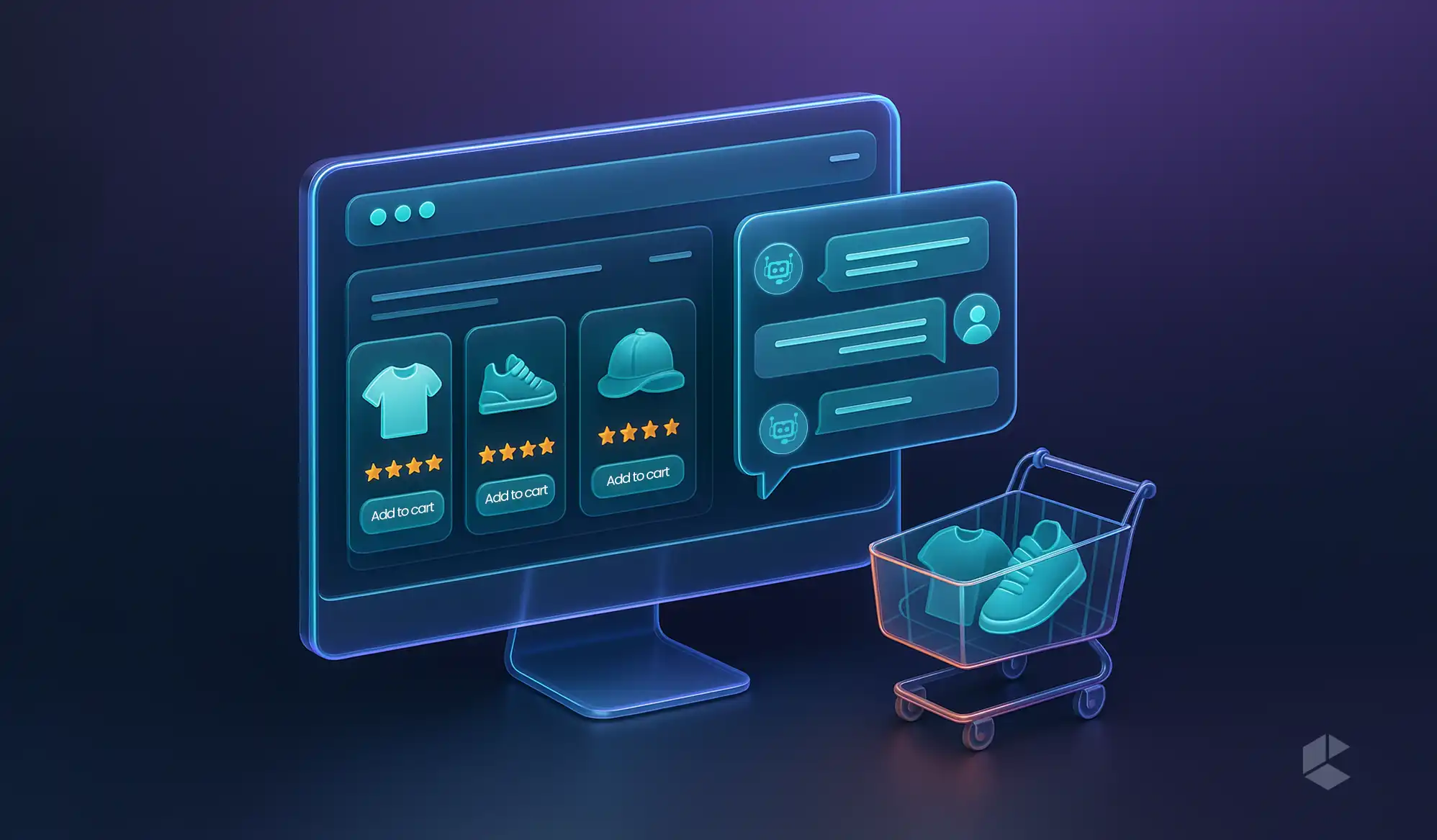- Voice commerce enables hands-free shopping through assistants like Siri or Alexa.
- Natural language product descriptions improve how voice assistants interpret store content.
- Fast site performance increases visibility in voice-driven product searches.
- Saved payment details make checkout quicker for returning voice commerce shoppers.
- Clear product data reduces misinterpretation by voice-powered shopping systems.
- Building customer trust is essential for successful voice commerce adoption.
Voice interactions are no longer the cool, futuristic idea that only sci-fi movies used to brag about. It has already quietly entered living rooms, smartphones, kitchens, cars, bedrooms, and basically any space where someone can say a few words out loud.
In the world of eCommerce, shoppers are absolutely eating it up because talking is a whole lot easier than typing. If you run a Shopify store, this shift is not something you can afford to ignore anymore. Voice commerce is becoming a natural extension of eCommerce convenience, and the sooner your store embraces it, the better your brand stacks up for the future.
Understanding Voice Commerce
Voice commerce lets shoppers buy products using spoken commands instead of tapping through pages. Customers simply activate their assistant like Siri, Alexa, or Google Assistant, say what they want, and the device handles search, recommendations, and checkout.
It works through devices people already own, mainly smartphones and smart speakers. These assistants interpret voice requests using voice recognition technology and match them to relevant product results.
From a shopper’s perspective, it feels natural because they can buy things while multitasking. Routine purchases become especially easy since customers do not need to research or type every time.
What makes voice commerce appealing
- Hands-free product search and browsing
- Quick reorder capability for frequently purchased items
- Secure checkout using previously saved payment details
- Faster decision making through conversational queries
Many retailers are already adopting voice-friendly interfaces that support smooth browsing, identity confirmation, and instant checkout, so customers can shop the way they prefer.
The Voice Shopping Experience in Real Life
Imagine you are doing something messy like washing dishes, and suddenly remember you need a new pair of running shoes. With your hands occupied, you would normally wait and risk forgetting it altogether. But with voice shopping, you can simply ask your assistant to find the best deal on running shoes. The assistant replies with options or follow-up questions about brand preference or features. Once you pick one, it adds the product to your cart and waits for your confirmation to complete the purchase.
Checkout is just as quick because most assistants store payment and delivery details securely in advance. You confirm the order verbally, and you are done.
This sense of immediacy is exactly why voice commerce is becoming popular among multitasking users. Shopping becomes part of the flow of daily life instead of a task that demands full attention.
Why Voice Commerce is Worth Adding to Your Shopify Store
Voice commerce offers several advantages for both customers and brands. Here are the major benefits, all based directly on the insights from your reference document.
1. Speed that actually makes a difference
Typing out long product names or navigating pages takes time. Speaking a sentence is significantly faster. Voice assistants can instantly interpret spoken queries and fetch relevant products almost immediately. Checkout also becomes quick because payment and shipping details can be saved in advance. This trims the entire shopping process from minutes to seconds.
Speed is one of the biggest reasons customers gravitate toward voice shopping. When people can make purchases quickly, they are far more likely to follow through instead of abandoning their cart.
2. Convenience that customers already expect
Most people today have a smartphone with built-in voice recognition. Many also use smart speakers at home or work. That means customers do not need any new device to shop through voice commands. They can browse and buy items while commuting, working, cooking, or relaxing.
The real advantage here is frictionless checkout. Since returning shoppers can rely on saved payment data, voice shopping lets them complete purchases without repeatedly entering details.
3. A boost in brand visibility and discovery
Voice commerce creates a unique opportunity for voice search optimization. By using natural, conversational product descriptions and relevant long tail keywords, your store becomes more discoverable in voice-based queries. When voice assistants fetch results for common searches, a well-optimized store can appear more frequently.
This naturally improves brand visibility and increases the chances of conversion, especially for routine products or items that have loyal repeat buyers.
The Challenges You Need to Be Aware Of
Before implementing voice commerce in your Shopify store, it is important to understand the limitations. Even though voice shopping is promising, it still comes with obstacles that brands need to plan for.
1. Initial setup costs
Voice commerce does require some investment. You need the right AI-powered eCommerce capabilities and a platform that supports natural language processing. Your store must also be prepared to handle secure voice-based purchases. Not every brand can jump in immediately without a budget.
2. Customer privacy and security concerns
Some customers hesitate to make purchases verbally, especially when it involves financial details. Sharing a voice print, payment information, and personal data through a voice assistant requires trust. Studies referenced in your document indicate that more than a quarter of online buyers express concerns about security during voice shopping.
To build trust, your store must follow strict data protection practices and comply with privacy regulations.
3. Imperfect technology limitations
Voice recognition is powerful, but it is not flawless. Assistants sometimes misunderstand commands or fail to interpret accents, background noise, or vague instructions. When customers do not get accurate results, it can frustrate them and reduce future adoption.
As a Shopify store owner, your job is to prepare clean, clear product data that reduces misinterpretation as much as possible.
The Future of Voice Commerce
Voice-assisted shopping is growing steadily. Large numbers of online consumers already use voice assistants regularly for everyday actions. Transaction values handled through voice are rising sharply, and future projections indicate that voice purchases will play a major role in digital commerce.
While it is not guaranteed that voice shopping will surpass traditional eCommerce methods, it will definitely become a significant channel. Early adopters include giants like Amazon, Walmart, and Starbucks, but smaller retailers can tap into this trend too.
For Shopify merchants, this is the perfect time to start integrating voice commerce features rather than waiting for the industry to become crowded.
How to Prepare Your Shopify Store for Voice Search
Now that we have the foundations in place, let’s get into the actual “how”. Voice commerce sounds futuristic, but the core idea is simple. Your Shopify store needs to be discoverable, understandable, and fast enough for voice assistants to interact with it smoothly.
1. Optimize Your Store for Voice Search
This is the biggest and most crucial step. Voice assistants rely heavily on search results. If your store does not show up properly in search engines, it becomes harder for assistants to surface your products when customers ask for them.
The reference file clearly mentions three core areas you should focus on:
A. Assess your site performance
Start with a website grader or a performance checker that evaluates site speed. Voice assistants prefer fast and high-performing websites because delays disrupt the flow of the conversation. A slow site reduces the likelihood that your pages show up as recommended results.
Fast loading improves your ranking, which is directly useful for voice search visibility.
B. Write product descriptions in natural language
Voice search queries are usually conversational. People do not talk the way they type. Voice queries often sound like:
- What is the best running shoe for daily jogging
- Find a cotton sweatshirt under a certain price
- Look for organic face wash near me
If your product descriptions read like stiff keyword-stuffed blurbs, voice assistants will have a harder time connecting the dots.
Your descriptions should feel like something a person might say out loud. The reference specifically calls out natural language and long tail keywords as important. This helps assistants interpret your product pages more accurately.
C. Follow general SEO best practices
A well-optimized store increases your chances of being included in the results delivered by assistants like Siri or Alexa. From the reference material, the idea is simple. The better your search rankings, the easier it is for voice assistants to find your store.
The takeaway is straightforward. Voice commerce starts with search visibility. No visibility means no voice-driven sales.
2. Make Your Store Easy for Voice Assistants to Interpret
Voice assistants need clarity. If your store’s content is confusing, inconsistent, or lacking detail, assistants are more likely to misunderstand requests. The reference highlights an important limitation. Voice recognition systems sometimes struggle to understand complex or unclear commands.
Your job is to make your store’s content as error-proof as possible.
A. Keep product names clean and descriptive
A customer might say something like “Find soft linen pillow covers” or “Buy protein powder for heart patients.” The more your product titles resemble how customers speak, the more correctly the assistant will match them.
B. Avoid vague product descriptions
If your product page does not clearly specify size, color, features or variations, voice assistants may not know how to match the spoken query with the correct item.
C. Use structured data properly
While the reference file does not give technical steps, it does emphasize that technology needs to be able to understand requests accurately. Structured data helps search engines classify your products correctly, which makes voice results cleaner and more precise.
3. Make Checkout Voice Friendly
Voice commerce shines the most during checkout. Customers love hands free shopping because they can finalize purchases with a single spoken confirmation. Your Shopify store should support this flow.
The reference document makes one point very clear. Voice assistants rely on stored customer information. If shoppers have saved payment and address details within their account, purchases become instant.
What this means for your Shopify store
- Encourage logged-in shopping
- Make it easier for customers to save cards or addresses
- Clean up your checkout flow so assistants do not get stuck on unnecessary steps
Checkout should be short and straightforward. A complicated checkout reduces the success rate of voice-driven purchases.
4. Prepare Your Store for Repeat Purchases
Voice commerce thrives on habitual, routine buying. Customers often use voice assistants for reordering items they already buy regularly. The reference document specifically mentions routine purchases as a key strength of voice shopping.
Your Shopify store should be structured to support:
- Reordering with minimal friction
- Quickly finding previous items
- Making follow-up purchases simple
This increases the likelihood that a customer will literally say “Buy that thing again” and complete their order without second-guessing.
5. Build Customer Trust Around Voice Commerce
One of the major challenges outlined in your reference document is privacy and security concerns. Customers hesitate because they worry about sharing financial information and voice prints verbally.
As a Shopify merchant, this sensitivity cannot be ignored.
A. Highlight security measures clearly
Even though Shopify itself handles secure checkout, customers feel safer when you explicitly mention data protection policies on your site.
B. Reassure users that stored data is protected
Since voice commerce relies heavily on previously saved information, customers should feel comfortable storing credentials in their accounts.
C. Stay aligned with privacy guidelines
According to the reference, staying updated with regulations is a direct way to build trust. Customers are more likely to use voice features when they believe their data is safe.
6. Plan for the Limitations of Voice Commerce
The reference document is blunt about the shortcomings. Voice recognition is not perfect. Assistants can misunderstand commands, mispronounce brands, or misinterpret accents.
You cannot control voice assistant accuracy, but you can reduce friction by:
- Ensuring your product names are unambiguous
- Ensuring variations are clearly labeled
- Providing clean and detailed product content
- Avoiding duplicate product titles
A voice assistant can only match what it understands. Anything unclear increases the chance of a mismatched result.
7. Learn from What Big Retailers Are Already Doing
The reference mentions Amazon, Walmart, and Starbucks as early adopters. While you cannot copy their tech stack, you can certainly learn from their approach.
Their success comes from:
- fast search
- clean product information
- simplified checkout
- customer trust
You can recreate the same principles on your Shopify store without the enterprise-scale complexity.
8. Use Voice Commerce Insights for Branding Too
Voice commerce is not only functional. It also affects brand visibility. The reference document points out that optimizing your store for natural language improves your SEO and visibility in voice queries.
This means:
- customers discover your brand more easily
- you become part of the recommended results
- your store appears in more conversational searches
Voice search uses long tail, conversational phrases. When your content mirrors that pattern, your brand becomes discoverable in moments when people are actively looking to buy something.
Conclusion
Voice commerce is on the rise, and Shopify merchants who act early will have a real advantage. Shoppers love speed, convenience, and reduced friction. They already use voice assistants daily, not just for shopping but for almost everything else in their digital life.
Your job is to make your store understandable, discoverable, and easy for voice assistants to interact with. The reference document makes it clear that voice commerce is not about replacing traditional eCommerce. It is about giving customers another way to shop that feels natural, quick, and effortless.
FAQs
Voice commerce lets customers use assistants like Siri or Alexa to search products, get recommendations, and complete checkout using saved payment details, creating a smooth, hands-free shopping experience.
You need fast site performance, natural language product descriptions, clear product data, and strong SEO so voice assistants can correctly interpret queries and surface your store during searches.
Voice assistants make reordering incredibly simple because customers can verbally request previously purchased items, allowing faster routine purchases without navigating pages or entering their details again.
Voice commerce faces issues like upfront setup costs, customer privacy concerns, and occasional misinterpretation of spoken commands, making it important to maintain clean content and strong trust signals.
Use conversational language, long tail phrases, structured product information, and ensure fast load speeds. Better optimization increases visibility when assistants recommend stores during voice-based product searches.









